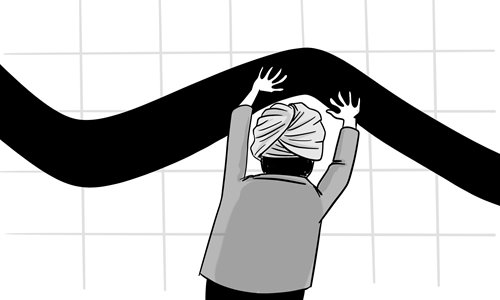HOME >> BUSINESS
Indian economy vulnerable amid global slowdown
By Wang Jiamei Source:Global Times Published: 2019/9/10 19:33:39

Illustration: Luo Xuan/GT
The Indian economy expanded at 5 percent year-on-year in the second quarter of 2019, the slowest pace in over six years. The data emerged not long after Indian Prime Minister Narendra Modi expressed his confidence that India can become a $5-trillion economy by 2024. The previous quarter also saw the country lose its title of the world's fastest-growing economy, with GDP growth of 5.8 percent.
Many attributed the downturn to cyclical factors and structural problems plaguing the economy. A sharp slowdown in investment and consumer demand affected the manufacturing sector, which grew by just 0.6 percent in the second quarter, much lower than the 12.1 percent gain during the same period last year. The poor external economic environment is also seen as an important factor behind the sudden drop in India's economic growth.
Fundamentally, India's lack of economic resilience underscores the structural problems in its economy, which has placed too much focus on the services sector.
No one could doubt the importance of industrialization for a country to achieve modernization, which is why China made great efforts to become the "world's factory" in the past. But while China attached great importance to manufacturing, India chose to develop its services sector, which has caused its predicament today. After decades of development, the services sector hasn't helped India to accumulate the technology that could allow it to gain a foothold in global industrial production. Most Indians are still engaged in low-tech sectors, and only a small group of highly educated people are engaged in high-end services, and this situation doesn't offer enough impetus to drive a country with such a large population.
In this context, the Modi government launched the "Make in India" campaign to facilitate the development of its manufacturing industry in 2014. Since a strong manufacturing sector would inevitably require labor support, the development of manufacturing could solve the employment problem for the country. Moreover, skilled workers are also essential for the development of manufacturing, which would also promote the development of education in the country. Although it seems that India has begun to pay attention to the need for manufacturing development, it may be too late, as its efforts are coinciding with a worsening external environment. Due to the global economic slowdown and even an imminent recession, manufacturing sectors around the world are under pressure, and India's would be no exception. With most of its manufacturing at the low-end or middle of the global value chain, its manufacturing development is subject to many constraints. Unlike China, which was able to develop export-driven manufacturing in previous decades, India needs to facilitate its manufacturing development in an environment that is hard for manufacturing industries. In this sense, India's manufacturing development will be mainly driven by domestic consumption rather than external demand in the coming years.
Moreover, some familiar factors like poor infrastructure and obstructive labor laws and land ownership laws have also impeded industrial development in India, which is why Sonal Varma, Nomura's chief India economist, estimated at the China Investor Forum 2019 on September 5 that a consumption- and service-driven growth model will continue in the country.
It is because of India's inadequate manufacturing development that its economy is fragile and facing various problems. The most prominent one is unemployment. Official data showed that India's unemployment rate rose to 6.1 percent in the 2017-18 fiscal year, the highest level in 45 years. Meanwhile, low employment and slack wage growth jointly contribute to weak consumption. In the second quarter of this year, India's private consumption, which accounts for 60 percent of nominal GDP, rose just 3.1 percent year-on-year, compared to the 7.2 percent growth in the previous quarter.
Against such a backdrop, the Indian government recently rolled out reform measures for its banking sector, a move aimed at transforming the financial system to provide continued stimulus for economic growth. India's central bank has already cut interest rates four times this year, and the market is expecting a fifth cut in October. However, all these measures are just forms of short-term stimulus, which can hardly generate sustained momentum for the economy.
Of course, it should be admitted that India has also been engaged in a series of long-term reforms, such as the goods and services tax reform. But it remains to be seen whether such reforms can achieve breakthroughs in key areas like labor and land so as to help the country strengthen its economic resilience.
The author is a reporter with the Global Times. bizopinion@globaltimes.com.cn
Posted in: INSIDER'S EYE